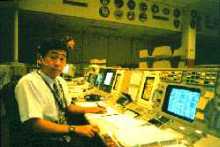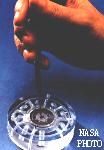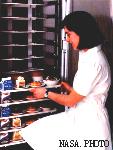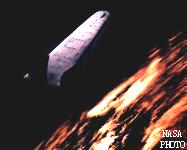
-
 "Flight
Surgeon" (FS) is an unfamiliar term in Japan; it is a vocation commonly
known in the USA and in Europe where there are many pilots. The FS is a
doctor specialized in the health care for pilots and astronauts and in
the aerospace medical research. "Flight
Surgeon" (FS) is an unfamiliar term in Japan; it is a vocation commonly
known in the USA and in Europe where there are many pilots. The FS is a
doctor specialized in the health care for pilots and astronauts and in
the aerospace medical research.
In 2005, there are four Japanese FSs in charge of developing
space medicine, and all of them belong to JAXA. Their primary
role is to ensure the health and safety of the astronauts.
Their work is mainly composed of selecting astronauts, periodic
medical examinations, health monitoring of the astronauts
before and during spaceflight, and postflight rehabilitation.
This photograph (see right) shows the mission control center
where FSs monitor astronauts' health condition.
Health care for long-duration spaceflights represents a large variety of
unsolved and thus challenging problems which can only be approached by
dedicated studies designed especially for these purposes. JAXA medical
doctors, nurses and technicians are occupied in such studies. |

- The health care for astronauts based on space medical research was
first initiated in Japan on the three astronauts selected in 1985,
and later on, on two more astronauts. So far, JAXA has participated
in four manned space missions with them, slowly but steadily accumulating
experience.
What is the difference, then, between the health care for astronauts
and the regular medical examinations? The health care for astronauts
is composed of the thorough medical examinations described below through
the cooperation between NASA and the JAXA's FS.
4.1 Preflight medical care
- Astronauts are examined annually to determine whether they may participated
in spaceflight. The examination includes physical examinations performed
by the FS, clinical laboratory tests (analyses of blood, urine and
feces), electrocardiography, pulmonary function test, audio and visual
examinations, and dental examinations. Additionally, simplified medical
examinations are scheduled on the tenth and second days before launch.
Moreover, health stabilization program, which is characteristic in
the health care for astronauts, is implemented. Astronauts are isolated
from all but a few key persons about one week before launch to protect
them from infectious diseases. During this week, the number of persons
who have contact with the astronauts is minimized.
4.2. In-flight medical care
- In view of the upcoming ISS era, NASA is presently setting up the
Crew Health Care System(CHeCS) composed of the Health Maintenance
System (HMS), Environmental Health System (EHS), and Countermeasures
System (CMS). HMS includes Medical Kit; EHS includes water, air, microorganism
and radiation monitors; CMS includes the treadmill, ergometer, resistant
exercise device, and LBNP. All of these devices are scheduled to be
installed.
In the present Space Shuttle Mission, the FSs monitor continuous in-flight
safety and health care of the crew for 24 hours from Mission Control
Center (MCC) in Houston. Additionally, the FS and crew discuss the
medical problems in private once a day using a voice link, and the
FS can provide medical instructions when necessary. Besides, the condition
of life support system, the predicted amount of radiation exposure,
and vital information such as electrocardiogram are taken into account
for the health care. Through the previous experience of space flight,
health care know-how has been accumulated such as the injection of
medicine against space motion sickness, exercises for maintaining
muscle strength and the ingestion of isotonic saline just before reentry.
These countermeasures have shown significant effects in short-term
spaceflight, but, for new longer-term flights, health care procedures
should be established.
4.3. Space walk (Extravehicular Activity-EVA)
- Extravehicular activity is one of the most exciting events for everyone,
including the astronauts themselves. The Extravehicular Space Suit
Mobility Unit (EMU)
enables the astronauts to perform the EVA
for six to seven hours with safety in the extremely perilous environment
of space. The EMU is filled with 100% oxygen at 0.29atm. During the
EVA, the astronaut's vital data, such as the electrocardiogram, is
constantly monitored by FS from the ground. In the ISS, a total of
one thousand hours per year of EVA will be necessary. The development
of medicines which support these activities is indispensable.
4.4. Postflight medical care
- In the present Space Shuttle flight program, the astronauts receive
simple medical examinations by the FS in a specialized car docked
to the shuttle on landing day immediately after space fight. They,
then get off the Shuttle and receive medical examination and clinical
laboratory tests at a clinic. Three days after landing, more detailed
examinations are performed. If there are no irregular trends, this
is followed by an ordinary health care plan.
4.5. Health care in the International Space Station
- Health care procedure for ISS crew members should be established for
longer periods (up to three to six months) than for Shuttle mission crew
members. Pre- and in-flight health care and post-flight rehabilitation
will be more detailed, and the health care team will be composed of international
personnel.

- Some people may question how space medical research contributes
to medicine on the ground. Unlike the terrestrial medicine with which
doctors diagnose and treat patients, space medicine deals with specially
selected healthy persons and overcoming the adverse effects anticipated
in space. However, there are many spinoffs arising from space medical
research, some of which are highlighted here. You will find them directly
beneficial to our daily medical use.
5.1. Blood Analyzer
-

A common medical instrument is the blood analyzer. In the 1970s, existing
mechanical analysis blood systems were far too large for spacecraft use
and would not have functioned properly in microgravity. For the Skylab
manned orbital laboratory, a toaster-sized centrifugal analyzing device
was developed with funding provided by NASA (see right). It is an epoch-making
system which can perform 80 to 100 chemical blood tests using a single
drop of whole blood. |
5.2. Vision therapy
- Recently, vision therapy centers have sprouted up here and there
around town. These centers use the Accommotrac System, a device to
help sufferers from myopia (near-sightedness) and hyperopia (far-sightedness)
who cannot properly focus their eyes to use the ciliary body, a muscle
to control the thickness of the eye lens, without wearing glasses.
This device is a spinoff stemming from research in space medicine.
The investigator in NASA said that he himself suffered from myopia
but could considerably improve eyesight with this device.
5.3. Food Service System
-

Hospitalized patients look forward to the daily meals during
their monotonous stay in a hospital. A hot meal is an important
factor affecting their appetites. The Food Service System, which
is now widely used in hospitals, is originated in space technology
developed by NASA in 1966-67 for meal service aboard the Apollo
lunar spacecraft (see right). |
5.4. Other devices
-
There are other spinoffs too many to count but include:
Coronary arterialization by applying the low temperature laser, which was
originally developed for measuring air gas; a cutting-edge pacemaker which
can change the heart rate in response to body activity; a temperature capsule
for measuring internal body temperatures (see right) with the application
of battery technologies; a vision screening device for children's eyesight
and so forth. There are also space medicine technologies that have potential
for practical use in preventing and curing osteoporosis, curing muscle
atrophy diseases, rehabilitating program for patients of cerebral infarction
and cardiac insufficiency, and so forth.
JAXA is conducting a Bed
Rest Study with the cooperation of healthy volunteers. Bed
rest with six degrees head down tilt causes a fluid shift toward
the head and unloading of bone and muscle and is thus supposed
to simulate microgravity. Using bed rest studies, we can investigate
effects of microgravity and develop health care procedures for
astronauts. Many other research projects are conducted in JAXA's
Tsukuba Space Center to promote astronauts' health and well-being. |

-

An unprecedentedly huge structure will soon be constructed in space. Japan
is also entering a new era of long-term spaceflight. Space medicine that
originated from aerospace medicine in the 1940s is now rapidly developing
to meet the requirements when common citizens as well as astronauts expand
their habitats to space. We are attempting to use an international laboratory,
investing in tomorrow, in search of greater scientific knowledge which
may contribute to maintaining the beautiful environment on Earth so that
the next generation can live safely. It is our hope that the importance
of manned space development will be fully understood by more and more people. |
-
Last Updated : December 5, 2013
|
 "Flight
Surgeon" (FS) is an unfamiliar term in Japan; it is a vocation commonly
known in the USA and in Europe where there are many pilots. The FS is a
doctor specialized in the health care for pilots and astronauts and in
the aerospace medical research.
"Flight
Surgeon" (FS) is an unfamiliar term in Japan; it is a vocation commonly
known in the USA and in Europe where there are many pilots. The FS is a
doctor specialized in the health care for pilots and astronauts and in
the aerospace medical research.